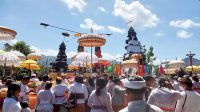EMBARK on a journey into the heart of Bali during Galungan Day, a festival that illuminates the island with vibrant colors and profound spirituality. Make your time to witness the celebration of the triumph of good over evil as communities come together in a spectacular display of culture, tradition, and devotion.
This celebration held every 210 days, falling on Buda (Wednesday) Kliwon Dungulan, encapsulates the essence of Balinese Hinduism, offering both locals and visitors a captivating glimpse into a world where faith, community, and heritage intertwine.
Significance of Galungan
Galungan marks the victory of dharma (good) over adharma (evil) and honors the ancestral spirits believed to return to Earth during this auspicious period. The festival symbolizes the perpetual cycle of life, death, and rebirth—a cornerstone of Balinese Hindu philosophy. Spanning ten days, Galungan culminates in Kuningan, a day when ancestral spirits return to the heavens, leaving behind blessings for their descendants.
Preparations and Festive Atmosphere
Days leading up to Galungan are a hive of activity across Bali. Homes and temples are adorned with ‘penjor,’ intricately crafted bamboo poles draped with young coconut leaves, fruits, and flowers, symbolizing prosperity and gratitude. The island comes alive with vibrant processions, traditional music, and elaborate offerings known as ‘banten,’ presented to deities and ancestors with reverence and devotion.
Each working equipment and means transportation such as hand tractors, motorbike and cars is also given rituals in order to get blessing and safety for the users while being operated. This is usually marked with the hanging sampian. So, it is not surprising if you encounter cars, trucks and motorbike are festooned with sampian at front side.
Prayers, Offerings, and Rituals
Central to the Galungan festivities are prayers and rituals performed at family temples and community shrines. Balinese families gather to worship, offering ‘canang sari’—small woven baskets filled with flowers, rice, and incense—as a symbol of gratitude to the gods. Priests chant sacred mantras, and the air resonates with the melodious sounds of ‘gamelan,’ traditional Balinese music that amplifies the festival’s spiritual ambiance.
Cultural Celebrations and Unity
Galungan transcends religious boundaries, fostering unity and camaraderie among Balinese communities. Villages come together to organize ‘ngayah,’ a collective effort to prepare offerings, decorate temples, and ensure the festival’s success.
Culmination: Kuningan
As Galungan draws to a close, Bali embraces the final day of celebration: Kuningan. Families gather for elaborate feasts, offering special ‘offerings’ to bid farewell to ancestral spirits returning to the heavens. The island radiates with joyous festivities, as communities share blessings, exchange gifts, and reflect on the spiritual significance of Galungan.
The Galungan Festival is more than a religious observance; it is a manifestation of Bali’s soul—a harmonious blend of spirituality, culture, and community. As ‘penjor’ sway gracefully in the breeze and ‘canang sari’ adorn temples and homes, Galungan reminds us of the enduring traditions that define this enchanting island. Whether you’re a spiritual seeker, cultural enthusiast, or curious traveler, experiencing Galungan in Bali is an immersive journey into the heart of Balinese Hinduism and a celebration of life’s eternal cycles.
This year, the Galungan falls on Buda (Wednesday) Kliwon Dungulan (Feb 28 and Sep 25). Meanwhile, the Kuningan falls ten days after Galungan.










